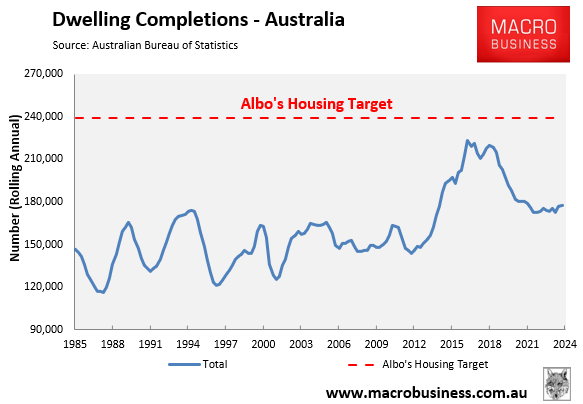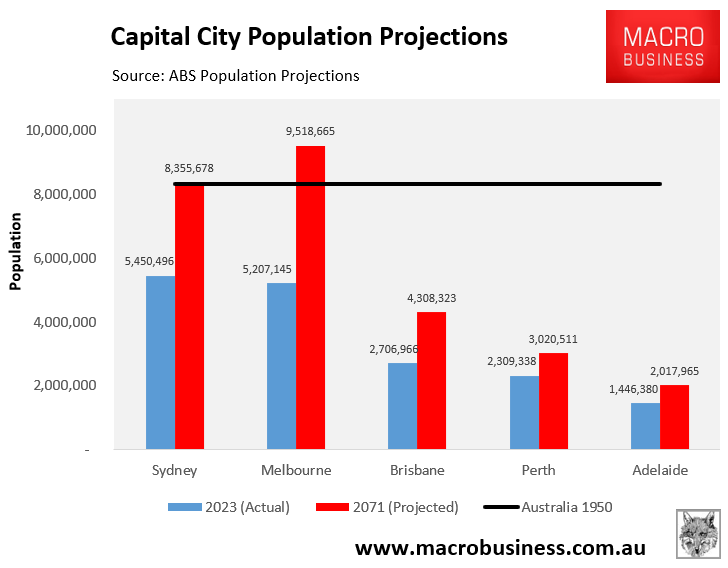The Albanese government has set a fantastical target of building 1.2 million homes over five years.

To meet this target, Australia would need to build many shoebox apartments.
New South Wales and Victoria have introduced planning reforms allowing the blanket construction of high-rise towers across Sydney and Melbourne activity centres.
The widespread push for density amid extreme immigration-driven population growth will make our cities hotter because it will require the destruction of heat sinks such as lawns, gardens and trees.
As reported in The Age, the Victorian Allan government’s 30-year development blueprint, Plan For Victoria, introduces standards allowing a three-storey building to be automatically approved without giving neighbours the right to appeal.
At the same time, Plan For Victoria has set a target to magically grow Melbourne’s tree canopy cover to 30% in urban areas.
“Metropolitan Melbourne has about 15.3% tree canopy, but the city’s western and northern suburbs fare worse”, wrote Sophie Aubrey from The Age.
“Even the leafiest of eastern councils do not have 30% tree canopy cover, and they fear this target can’t be achieved under the new planning rules”.
“The government says it wants 30 per cent tree canopy cover, yet the [planning] changes do the exact opposite – shrinking setbacks, reducing open space and making it even easier to remove trees”, City of Boroondara mayor Sophie Torney said.
“You can’t have it both ways. Without space for trees to grow, the target is meaningless”.
“Add to that the lack of controls on private dwellings, and we’re looking at a loss of green cover at a time when we need the opposite”, Torney said.
City of Whitehorse mayor Andrew Davenport agreed, warning that the state government’s planning changes eroded the council’s ability to protect tree cover and would “seriously undermine” its canopy goals.
Blackburn and District Tree Preservation Society president David Morrison also believes the government’s canopy targets do not add up.
“It’s disheartening and concerning”, Morrison said. “The government is conflicted in its own policies. It wants a greener, cooler Melbourne while … trying to pack more and more buildings in”.
Melbourne is projected to experience the most substantial population increase over the next 48 years, growing by 4.3 million (83%) to 9.5 million people:

To keep pace with its rapid population growth, the Victorian government has set a target of building 2 million additional homes by 2051.
According to the 2021 Census, Melbourne had 2,057,482 homes and Victoria had 2,805,661.
As a result, in only 30 years, Victoria is expected to have a 71% increase in homes, predominantly apartments.
Meeting the state government’s housing targets would entail destroying green space as housing density cuts down trees and eats up lawns and gardens.
According to an SGS Economics & Planning report, Melbourne is expected to have 25% less open space per person in two decades, jeopardising the city’s “garden state” moniker.
Melbourne has around 13,000 hectares of public open space for public enjoyment, which includes 5547 hectares of parks and gardens, 5100 hectares of sporting ground, and approximately 28 hectares of “civic squares and promenades”.
That works out to about 24 square metres per person, which is less than two parking places.
By 2043, the average person may only have 18 square metres of public open space. Obviously, the situation would worsen if Melbourne expanded to 9.5 million people by 2071.
Open space and greenery are another casualty of the Big Australia mass immigration policy, which requires the destruction of backyards and flora in order to increase population density.
Increased densities will also compound the heat island effect, making our cities hotter in the future.

